Operation Gauntlet
Operation Gauntlet (25 August – 3 September 1941) was an Allied Combined Operation during the Second World War. Canadian, British and Free Norwegian Forces landed on the Norwegian island of Spitsbergen in the Svalbard Archipelago, 650 mi (1,050 km) south of the North Pole.
Coal mines on the islands were owned and operated by Norway at Longyearbyen and by the Soviet Union at Barentsburg; both governments agreed to their destruction and the evacuation of their nationals. The objective of Operation Gauntlet was to deny the Germans the coal, mining and shipping infrastructure, equipment and stores on Spitzbergen and suppress the wireless stations on the archipelago, to prevent the Germans receiving weather reports.
Operation Gauntlet was a success; the Germans had not known of or had been able to challenge the expedition, the raiders suffered no casualties, the local civilians were repatriated, several ships were taken as prizes and one German warship was sunk on the return journey.
Background
Naval operations
From 25 July to 9 August 1940, the Admiral Hipper sailed from Trondheim to search the area from Tromsø to Bear Island and Svalbard (formerly Spitzbergen) and intercept British ships returning from Petsamo but found only a Finnish freighter.[1] Action to deny Germany its coal exports was mooted by the British War Cabinet and the Admiralty soon after the German occupation of Norway in 1940. It was also desirable that wireless stations on the islands, which supplied un-coded weather reports which were useful for German military operations, be suppressed. After Operation Barbarossa, the German invasion of the Soviet Union on 22 June 1941, German occupation of the islands could threaten the Arctic convoy route to North Russia.[2] On 12 July 1941, the Admiralty was ordered to assemble a force of ships to operate in the Arctic, in co-operation with the USSR, despite objections from Admiral John (Jack) Tovey, commander of the Home Fleet, who preferred to operate further south, where there were more targets and better air cover.[3]
Rear-Admirals Philip Vian and Geoffrey Miles flew to Polyarnoe in northern Russia and Miles established the British military mission in Moscow.[3] Vian reported that Murmansk was too close to German held territory, that its air defences were inadequate and that the prospects of offensive operations on German shipping were poor. Vian was then sent to reconnoitre the west coast of Spitzbergen, the main island of the Svalbard Archipelago, which was mostly ice-free and 450 mi (720 km) from northern Norway, to assess its potential as a base. The cruisers HMS Nigeria, HMS Aurora and two destroyers departed Iceland on 27 July but Vian found that the advantages of a base at Spitzbergen, were nullifed by the obstacles of weather and proximity to German bases in Norway.[4] The force closed on the Norwegian coast twice and each time was discovered by Luftwaffe reconnaissance aircraft and retired.[5]
Svalbard Archipelago
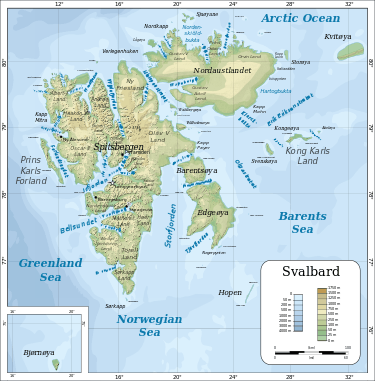
The Svalbard Archipelago is in the Arctic Ocean 650 mi (1,050 km) from the North Pole and a similar distance north of Norway. The islands are mountainous, the peaks permanently snow covered, some glaciated; there are occasional river terraces at the bottom of steep valleys and some coastal plain. In winter the islands are covered in snow and the bays ice over. Spitzbergen Island has several large fiords along its west coast and Isfjorden is up to 10 mi (16 km) wide. The Gulf Stream warms the waters and the sea is ice-free during the summer. Settlements were established at Longyearbyen and Barentsberg in inlets along the south shore of Isfjorden, in Kings Bay, north up the coast and in Van Mijenfjorden to the south. The settlements attracted colonists of different nationalities and the treaty of 1920 neutralised the islands and recognised the mineral and fishing rights of the participating countries. Before 1939, the population consisted of about 3,000 people, mostly Norwegian and Russian, who worked in the mining industry. Drift mines were linked to the shore by overhead cable tracks or rails and coal dumped in winter was collected after the summer thaw. By 1939 production was about 500,000 long tons (510,000 t) a year, roughly evenly divided between Norway and Russia.[6]
Prelude
Allied preparations
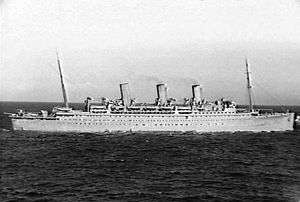
On 26 July 1941, the Canadian Corps in Britain offered to provide sufficient troops for a landing on Spitzbergen, to garrison a naval refuelling base for four months and then withdraw before winter.[2] Force 111 was to be raised, comprising two battalions of a Canadian infantry brigade less transport and attached units including an anti-aircraft battery. The Canadians offered the HQ of the 2nd Canadian Infantry Brigade (Brigadier Arthur Potts) and its signal section, the 3rd Field Company Royal Canadian Engineers (RCE).[7]
A battalion each of Princess Patricia's Canadian Light Infantry and the Edmonton Regiment was attached and two field hospitals of the 5th Field Ambulance Royal Canadian Army Medical Corps (RCAMC) and detachments of administrative troops accompanied the expedition. The War Office added the 40th Field Battery Royal Canadian Artillery (RCA), with eight 25-pounder field guns from the 11th Field Regiment RCA; Force 111 was ready by 4 August.[7]
Plan
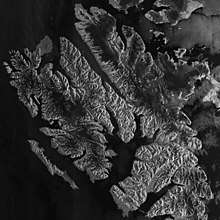
The Canadians embarked on RMS Empress of Canada in Glasgow, sailed for No.1 Combined Training Centre at HMS Quebec, Inveraray on Loch Fyne and began rehearsing the landings. On 11 August, Potts was told that the operation had been considerably reduced in scope, and on 16 August, Potts was ordered to ensure "that the Germans get no advantage out of Spitzbergen between now and March, 1942". The operation was to be a landing of a force sufficient for the demolition or the removal of mining equipment, coal and the transport and harbour infrastructure. Wireless and weather stations were to be disabled; the Russians were to be transported to Archangelsk and the Norwegians to Britain.[8]
Russian and Norwegian civilian representatives and a Norwegian army officer, the Governor Designate of Spitzbergen, would accompany the expedition to manage civilian matters. Force 111 returned to Surrey except for the 2nd Canadian Infantry Brigade HQ with 29 Canadian officers and 498 other ranks from the Edmonton Regiment (Major W. G. Bury) and the 3rd Field Company RCE (Major Geoffrey Walsh), 84 men of the Saskatoon Light Infantry (M.G.) and administrative parties, 14 British officers and 79 men, including 57 Royal Engineers and a Norwegian infantry party (Captain Aubert) with three officers and 22 other ranks, a total of 645 men.[8]
Operation Gauntlet
19–24 August
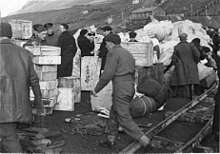
The expedition sailed from the River Clyde on 19 August in Empress of Canada and rendezvoused with Force A (Vian) with the cruisers Nigeria, Aurora and the destroyers HMS Anthony, HMS Antelope and HMS Icarus. The ships put in at Hvalfjörður, Iceland to refuel and departed on the evening of 21 August. Late on 22 August, the destination of the force was revealed to the troops. Force A met the oiler RFA Oligarch and its trawler escorts on the evening of 24 August, west of Spitzbergen and as the force moved in, an aircraft made a reconnaissance flight over Isfjorden a large inlet on the western coast of Spitzbergen island, the most populated area of the archipelago.At 4:30 a.m. Icarus landed a signal party at the Kap Linne wireless station at the entrance to the fiord, where they were welcomed by the Norwegian operators. The big ships entered Isfjorden, steamed on to Grønfjorden (Green Fiord or Green Harbour) at 8:00 a.m. and anchored off the Russian mining township of Barentsburg. Potts went ashore to confer with the Russian authorities about the embarkation of the population and its delivery to Archangelsk as the Canadians occupied other Russian and Norwegian settlements along Isfjord.[9]
25 August – 2 September
The evacuation proceeded slower than planned because the Russian Consul wanted machinery and stores loaded on Empress of Canada as well as personal effects. Empress of Canada set out for Archangelsk at midnight on 26/27 August, escorted by Nigeria and the destroyers. Aurora stayed behind to guard the landing parties and assist in the removal of the remoter settlements. The Canadian engineers set fire to about 450,000 long tons (460,000 t) of coal heaped at the mines, fuel oil was poured into the sea or burned and mining equipment was removed or sabotaged, during which, Barentsburg was mysteriously burned down. On the evening of 1 September the Empress of Canada and its escorts returned from Archangelsk to Green Bay.[10] Normal business was kept up at the wireless station by the Norwegian Military Governor Designate, Lieutenant Ragnvald Tamber except for bogus reports of fog, to deter Luftwaffe air reconnaissance and three colliers sent from the mainland were hijacked along with a whaler, an ice-breaker a tug and two fishing boats. On 2 September, about 800 Norwegians went on board Empress, along with 186 French army prisoners of war who had escaped from German captivity and been interned in the USSR until the German invasion. The force sailed for home on 3 September, with 800 Norwegian civilians and the prizes.[11][12]
3–27 September
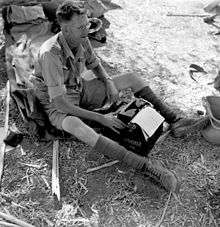
Force A departed Svalbard at 10:30 p.m. on 3 September, after ten days' occupation, having never been in darkness. Anders Halvorssen preferred not to join the Norwegian army-in-exile, hid and remained on the island. The final wireless message was transmitted on the evening of 3 September and the sets at Barentsburg, Longyearbyen, Kap Linné and Grønfjord were destroyed; as Force A made its return journey, a German station was heard calling Spitzbergen. The spurious weather reports had led to the cancellation of reconnaissance flights by Wettererkundungsstaffel (Wekusta 5) but on 5 September a sortie was flown over Svalbard and the crew found that Spitzbergen was deserted ad the coal dumps were on fire. Wekusta 5 resumed flights and on 10 September the crew saw Halvorssen waving to them at Longyearbyen; the crew saw a river terrace at Sònak in Adventfjorden, about 4 mi (6.4 km) away, about 1,500 yd (1,400 m) long, which could serve as a runway.[13]
On 25 September, a Ju 52 landed safely at Sònak but was unable to send a message due to the low power of its radio; a Ju 88 managed to land on 27 September, finding the party and the Norwegian defector. A plan to establish temporarily a base was abandoned after odd illumination, resembling searchlights, was seen in the sky and the two aircraft hurriedly took off for Norway, in case it was the British.[13] The British cruisers diverted towards the Norwegian coast to hunt for German ships and early on 7 September, in stormy weather and poor visibility, found a German convoy off Porshanger, near the North Cape. The cruisers sank the training ship Bremse but two troop transports, with 1,500 men aboard, escaped. Nigeria was thought to have been damaged hitting a wreck.[14][lower-alpha 1] Force A returned to the Clyde on the night of 7/8 September.[12][15][11]
Aftermath
Analysis
Operation Gauntlet was successful; the Germans had not known of or had been able to challenge the expedition. The raiders had suffered no casualties, the local civilians were repatriated, several ships were taken as prizes and one German warship was sunk on the return journey.[12] After the operation, the British expected the Germans to occupy Svalbard as a base for attacks on Arctic convoys but the Germans were more interested in meteorological data, the Arctic being the origin of much of the weather over western Europe.[16]
Subsequent operations
The Arctic expert, Dr Erich Etienne, made a proposal on his return to Norway, to set up a weather station on Svalbard to obtain better weather data and to relieve Wekusta 5 of the burden of flying in the long night of the polar winter. Operation Bansö began on 8 October with the flight of a Ju 52 to Svalbard to transport a weather party of four men and ten labourers to convert a house 2.5 mi (4.0 km) from Longyearbyen, near the landing ground at Sònak. On 18 October, the crew of a Ju 52 heading for Longyearbyen saw several British ships near the island and next day, a He 111 crew saw four British minesweepers in Isfjorden. The two Ju 52s and the He 111 abandoned the airstrip, although engine trouble delayed one of the Ju 52s for two hours but clouds of dust in the valley obscured the German aircraft and they went unseen. The all clear was given on 22 October and by 9 November Bansö was operational, after 38 flights carrying 5 long tons (5 t) of equipment and 24 builders; on 2 November, a Ju 88 escort for a Ju 52 was caught by a gale force wind and crashed soon after taking off from Banak, the crew being killed.[17]
Order of battle
Canadian (Data taken from Dean and Lackenbauer [2017] pp. 35–36 unless specified.)[18]
- Headquarters, 2 Canadian Infantry Brigade
- Signals Section, 2 Canadian Infantry Brigade
- 3 Field Company, Royal Canadian Engineers
- D Company, plus one platoon C Company, Edmonton Regiment
- Saskatoon Light Infantry (Machine Gun, Composite detachment)
- Detachment, Royal Canadian Army Medical Corps (5 Canadian Field Ambulance)
- X Canadian Field Cash Office, Royal Canadian Army Pay Corps
- Empress of Canada Ship’s Staff (from Edmonton Regiment)
(Canadian War Correspondent Ross Munro)
British
- Detachment, Kent Corps Troops, Royal Engineers
- Detachment, 992 Docks Operations Company, Royal Engineers
- Detachment, B Section 1 Motor Boat Company, Royal Army Service Corps
- Detachment, 60 Detail Issue Depot, Royal Army Service Corps
- D Field Cash Office, Royal Army Pay Corps
- Royal Engineers (Movement Control), Attached 2 Canadian Brigade Headquarters
- Intelligence Corps
- Army Film Unit
- Major H. C. Smith, Liaison Officer (Canadian serving in British Army)
- Captain E. W. Proctor, Royal Engineers
- Major A. W. Salmon, Royal Army Service Corps
Norwegian
- Detachment, Norwegian Infantry
See also
Notes
Footnotes
- ↑ Roskill 1957, p. 260.
- 1 2 Stacey 1956, p. 301.
- 1 2 Woodman 2004, pp. 10–11.
- ↑ Roskill 1957, p. 488.
- ↑ Woodman 2004, pp. 10–11, 35–36.
- ↑ Schofield & Nesbit 2005, pp. 61–62.
- 1 2 Stacey 1956, p. 303.
- 1 2 Stacey 1956, pp. 303–304.
- ↑ Stacey 1956, pp. 303–305.
- ↑ Stacey 1956, p. 305.
- 1 2 Roskill 1957, p. 489.
- 1 2 3 Stacey 1956, p. 306.
- 1 2 Kington, & Selinger 2006, p. 89.
- 1 2 Woodman 2004, p. 36.
- ↑ Woodman 2004, pp. 35–36.
- ↑ Schofield & Nesbit 2005, pp. 63–64.
- ↑ Kington & Selinger 2006, pp. 89−92.
- ↑ Dean & Lackenbauer 2017, pp. 35–36.
References
Books
- Kington, J. A.; Selinger, F. (2006). Wekusta: Luftwaffe Meteorological Reconnaissance Units & Operations 1938–1945. Ottringham, E. Yorks: Flight Recorder Publications. ISBN 978-0-9545605-8-4.
- Roskill, S. W. (1957) [1954]. Butler, J. R. M., ed. The War at Sea 1939–1945: The Defensive. History of the Second World War United Kingdom Military Series. I (4th impr. ed.). London: HMSO. OCLC 881709135. Retrieved 18 April 2018.
- Nesbit, Roy Conyers; Schofield, Ernest (2005) [1987]. Arctic Airmen: The RAF in Spitsbergen and North Russia 1942. London: W. Kimber. ISBN 978-0-7183-0660-1.
- Stacey, C. P. (1956) [1955]. Six Years of War: The Army in Canada, Britain and the Pacific. Official History of the Canadian Army in the Second World War. I (online 2008, Dept. of National Defence, Directorate of History and Heritage ed.). Ottawa: Authority of the Minister of National Defence. OCLC 317352934. Retrieved 18 April 2018.
- Woodman, Richard (2004) [1994]. Arctic Convoys 1941–1945. London: John Murray. ISBN 978-0-7195-5752-1.
Journals
- Dean, R.; Lackenbauer, P. Whitney (2017). Article 16. "Conceiving and Executing Operation Gauntlet: The Canadian-Led Raid on Spitzbergen, 1941". Canadian Military History. 26 (2). ISSN 1929-400X. Retrieved 18 April 2018.
Further reading
- Lawson, S. H. (2001). "D/S Isbjørn". Warsailors.com. Retrieved 16 April 2018.
- Levy, J. (2001). Holding the Line: The Royal Navy's Home Fleet in the Second World War (pdf) (PhD thesis). University of Wales Swansea (Swansea University). OCLC 502551844. Docket uk.bl.ethos.493885. Retrieved 2 June 2018.
- Ryan, J. F. (1996). The Royal Navy and Soviet Seapower, 1930–1950: Intelligence, Naval Cooperation and Antagonism (pdf) (PhD thesis). University of Hull. OCLC 60137725. Docket uk.bl.ethos.321124. Retrieved 2 June 2018.
- Sebag-Montefiore, Hugh (2001) [2000]. Enigma: The Battle for the Code (4th, pbk. Phoenix ed.). London: Weidenfeld & Nicolson. ISBN 0-75381-130-8.
- Stacey, C. P. (20 December 1941). The Spitzbergen Operation, August–September 1941 (Special Expedition 111; Exercise "Heather"; Operation "Gauntlet") (PDF) (Report). Canadian Military Headquarters, London: Department of National Defence, Ottawa, 1941. OCLC 961853652. Retrieved 21 August 2018.
- Vian, Philip (1960). Action This Day: A War Memoir. London: Frederick Muller. OCLC 185488211. D63-4/56-1941E-PDF.
_(Europe_centered).svg.png)